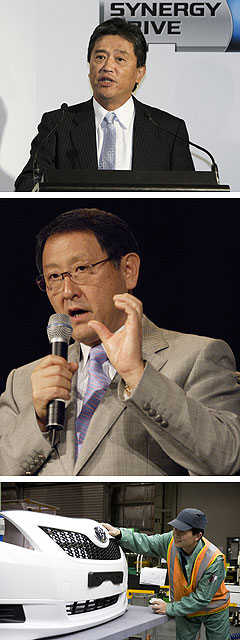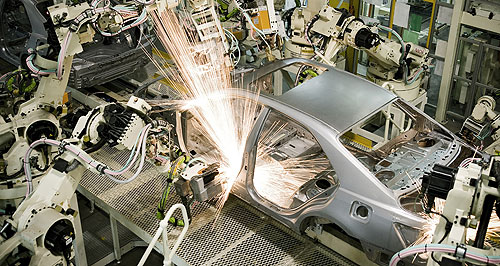News - ToyotaToyota on recovery trail after post-quake profit hitLine decision: Toyota Australia’s Altona plant will return to production of around 9000 vehicles a month from the week commencing June 6. Toyota to scale up production here and abroad after Q4 profit plummets 77 per cent12 May 2011 By TERRY MARTIN TOYOTA has announced a return to normal levels of production at its Altona plant in Victoria from June 6 as the Japanese auto giant recovers more quickly than previously expected from the devastating March 11 earthquake and tsunami. The earthquake was largely responsible for a 77 per cent fall in net income Toyota Motor Corporation (TMC) reported this week for the final quarter of its financial year ending March 31, with widespread production cutbacks forcing sales down across the globe. However, the world’s biggest car-maker – which is likely to lose its number-one ranking to General Motors as a result of the cutbacks – says global production will now begin returning to normal in June, rather than starting in July in Japan and in August outside its home market, as announced on April 22. In the first week of June, Toyota’s global production is expected to be carried out at around 70 per cent of normal output, depending on the region and vehicle model. In Australia, production has been reduced to 50 per cent of pre-earthquake levels since May 9 as a result of the limited availability of components necessary to build Camry and Aurion models at Altona. With a resumption of parts supply, Toyota will return production to around 9000 vehicles a month from June. The company says it is also “reasonably confident” it will be able to maintain this output into July and August.  From top: Toyota Australia president and CEO Max Yasuda, Toyota president Akio Toyoda, an employee at the Altona plant. From top: Toyota Australia president and CEO Max Yasuda, Toyota president Akio Toyoda, an employee at the Altona plant.“Toyota Australia and our suppliers have worked closely with Toyota Motor Corporation to secure the parts needed to resume normal vehicle production levels in early June,” said Toyota Australia president and CEO Max Yasuda. “This has involved studying and confirming the supply of critical parts from the earthquake-affected areas and identifying interim alternate suppliers. “The past two months have been challenging for Toyota Australia employees, dealers and suppliers, but their flexibility and support has been critical in helping the company get back on its feet quickly.” In Japan, Toyota this week made it clear that reduced production levels “may have significant impact on TMC’s business results”. Notably, TMC has declined to provide a forecast on vehicle sales, revenue and earnings for the current financial year due to the impact of the so-called Great East Japan Earthquake, saying that “more time is needed to complete the examination of production and sales plans”. Toyota’s global sales across all its brands in the final quarter fell 11 per cent (or 193,000 units) to 1.795 million compared to same period last year, while net income dropped to ¥25.4 billion yen ($A294.2 million) – down 77 per cent from ¥112.2b ($A1.30 billion) a year earlier. Revenue tumbled 12 per cent to ¥4.64 trillion ($A53.7b), compared to ¥5.28 trillion a year earlier. Just weeks prior to the earthquake, TMC announced on February 8 that it had forecast a full-year consolidated net income of ¥490 billion, but the subsequent events have wiped ¥81.9b off that for an actual result of ¥408.1b ($A4.73b), down 16.7 per cent. This is almost double the company’s result of ¥209.4 billion net income in the 2009/10 financial year, reflecting strong growth as Toyota steamed out of the global financial crisis and, in particular, increased sales in emerging markets. In its financial statements, Toyota attributes ¥110 billion ($A1.27b) to the impact of the earthquake, while the final (consolidated) sales figure for the fiscal year came in at 7.308 million units, up 71,000 or just one per cent. Toyota estimates the earthquake to have so far cost around 170,000 lost sales worldwide. The Japanese market suffered badly, reporting an operating loss of ¥188.0 billion ($A2.18b) last quarter, extending on the ¥1.5b loss it posted a year earlier, while for the full year Toyota’s home market was down ¥362.4b. Sales-wise, Japan was down 252,000 units for the quarter to 425,000 (including Daihatsu and Hino). Despite production cutbacks and its model recall crisis, Toyota’s most profitable market for the quarter, and full year, was North America, with operating income climbing out from a ¥21.2b Q4 loss last year to ¥88.4b in the black ($A1.02b) – more than the ¥85.4b it posted for the full year last year. For the full fiscal year, North America posted operating income of ¥339.5b, with Asia (which includes China, India and Australia but not Japan) the next best on ¥313b. Toyota’s Asian region also weathered the effects of the earthquake with ¥80.2b income in Q4 and 345,000 sales for the quarter, up 65,000 units on a year earlier. TMC president Akio Toyoda cast a positive light on the results, pointing to the company’s cost reduction and marketing efforts that contributed to the improved results over last financial year. Other Japanese manufacturers, including Suzuki Motor Corporation, have also held back on forecasts as the effects of the March 11 earthquake continue. Suzuki this week reported an 81 per cent fall in fourth-quarter profit, with net income of ¥2.57b ($A29.8 million) for the three months ending March 31, down from ¥13.42b over the same period last year. For the full year, Suzuki posted a net income of ¥45.2 billion ($A523.5m), with the company’s automobile segment contributing ¥2.32 trillion ($A26.9b) in sales. Operating income increased to ¥108.5b due to increased sales in emerging countries, notably India and Indonesia. Suzuki’s overall automotive sales volume for the year was 2.64 million units.  Read more2nd of May 2011  Slow sales, quake threaten to topple ToyotaToyota could lose largest car-maker title in 2011 due to recall, quake aftermath25th of April 2011  Toyota says quake cuts will drag onParts shortages set to keep brakes on Toyota’s Altona plant into June |
Click to shareToyota articlesResearch Toyota Motor industry news |
















Facebook Twitter Instagram